 By Bob Currie, Recreational Boating Safety Specialist
By Bob Currie, Recreational Boating Safety Specialist
U. S. Coast Guard Auxiliary Base Galveston Flotilla
Educators have long known that one of the best ways to teach is through music. We all can remember childhood songs long after we have grown up, and we often link those songs to certain memories. When I think about the wind, the song “They Call the Wind Mariah” always comes to mind. It was a popular ballad when I was growing up in the 1950s, so if the song name doesn’t ring a bell, I suggest you look it up and give it a listen. Here is the first verse of the song:
Away out here, they’ve got a name
For Rain and Wind and Fire
The rain is Tess, the fire’s Joe
And they call the wind Mariah
‘They Call the Wind Maria” is a once-popular American song written for the 1951 Broadway musical, “Paint Your Wagon,” which was set during the California Gold Rush. Maria in the song is pronounced Ma-rye-a, with the accent on the second syllable. Mariah Carey is named after the song, and her name is spelled the way it is pronounced in the song. So what does the song have to do with recreational boating? A look at the second verse will give you a good hint:
Maria blows the stars around
And sets the clouds a-flyin’
Maria makes the mountains sound
Like folks was out there dyin’
An important point to note is that in this song “Maria” isn’t a particular wind; rather it is the name for wind in general. What is interesting about this is that the inspiration for the song came from the 1941 novel, “Storm,” in which a particular storm was named Maria. It is just human nature to name things; that is how our brains work to form memories.
Probably no other force of nature has a greater effect on the world than the wind. There are two principle causes for the production of wind. First is the principle that hot air rises and cold air sinks. This can be a localized effect as well as a global effect. In coastal areas the sea breeze/land breeze cycle can define local winds. The second is the principle of winds caused by the rotation of the planet known as the Coriolis Effect (see diagram). Because surface ocean currents are driven by wind over the surface of the water’s surface, the Coriolis force affects the movements of ocean currents and cyclones as well. Recent studies show that the effect of wind over the water’s surface extends thousands of feet deep. These studies have led to a greater understanding of and a better ability to predict ocean currents.
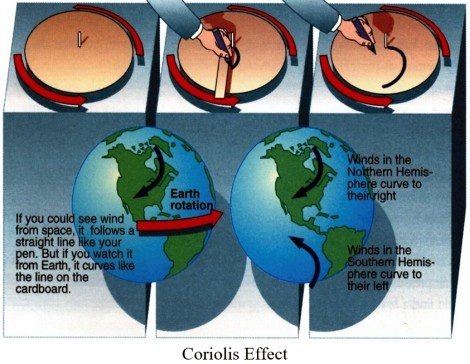
Wind and Weather
Weather in general is one of the most important factors in our lives. We need to know what the weather forecast is so we can dress accordingly as well as act accordingly. The cause of most weather phenomena is uneven heating of the earth’s surface. Wind and weather are almost the same thing, as wind drives the weather. Some important terms as they pertain to wind include:
- Apparent wind is the direction and force of the wind relative to a moving vessel. The motion of a vessel underway makes the effective wind vary from the actual wind direction.
- True wind is the actual direction and force of the wind.
- Backing wind is defined as winds which shift direction in a counter-clockwise direction in the northern hemisphere (clockwise in the southern hemisphere).
- Veering wind is a clockwise shift in the wind.
Local Effects on Wind
The largest temperature swings are with the seasons, but with the same input, the land heats faster than the ocean. The uneven heating and cooling of the land and ocean causes certain winds to develop near the shore. We call the winds that develop locally due to this uneven heating a sea breeze or a land breeze.
Keep this local effect in weather in mind when planning your fuel usage. Always keep one third of your fuel capacity in reserve because the local effect can greatly increase your fuel efficiency going out due to outgoing land breezes. If you use half of your fuel to reach your destination point, you will not make it back in as you will be fighting the wind, which will greatly decrease your fuel efficiency.
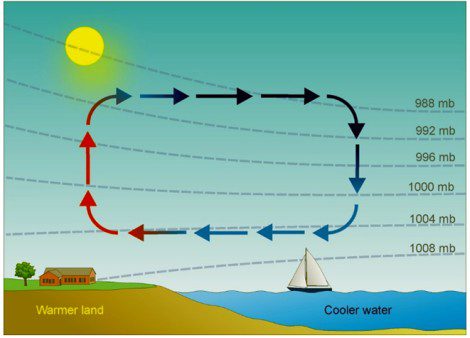
Sea Breeze
Boaters get underway in the calm hours of the cool early morning. By afternoon, when they try to get home, the bay or ocean is so choppy that they may find themselves in need of assistance. This calm to choppy tendency from the morning to the afternoon is due to winds that develop into what is called a sea breeze. The wind causes the waves to develop. The wind changes so drastically because as the sun warms the earth, the land warms faster than the surface of the water and radiates heat to the overlying air, warming it. The warm air rises, reducing the atmospheric pressure in the area. The air offshore over the ocean is cool, and cool air is dense and heavy. The cool air from the offshore flows inland in an attempt to equalize the pressure differential caused by the rising air. This flow produces the wind. Sea breezes typically reach their highest speeds during the period of maximum heating, around mid-afternoon.
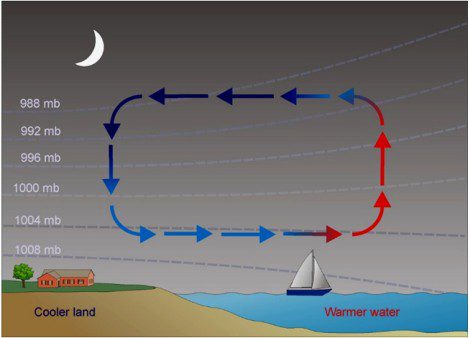
Land Breeze
After sunset, the inland area cools more quickly than the water, and the wind diminishes. In some areas a land breeze can be established late at night or early in the morning. For this breeze to occur, the sea surface temperature must be higher than the air temperature over land, along with weak winds prior to the breeze.
Safe Wind Speed for Boating
The safe wind speed for boating is … it depends. It depends on the shape of your hull, the length and weight of your boat, and your sail area, and especially upon your experience and the experience of your crew. Flat-bottomed boats and so-called bay boats are good in light winds but odds are they will pound in a moderate wind and be dangerous to operate in a heavy wind. Modified and deep-vee hulls cut through moderate winds but become difficult to handle in heavy winds. Winds are generally classified as follows:
- Light wind: 1-15 mph
- Moderate wind: 16-25 mph
- Heavy wind: 26-38 mph
- Gale wind: 39-54 mph
- Storm wind: 55-73 mph
If we waited for perfect weather, we wouldn’t spend much time on the water. Therefore, since the desire is to get out there, it is important to know your boat’s handling characteristics in all kinds of weather.
The Weather in Texas
The saying goes, if you don’t like the weather in Texas, just wait. It will change soon enough. That is not necessarily a good thing on the water. The prudent boater always has one eye to the sky to watch for changes in the weather. Low and dark clouds signify a storm. Light wispy clouds signify good weather. You should always check the weather forecast before leaving the dock.
Weather forecasters can reasonably predict the weather days in advance, but unexpected changes can occur due to the local weather effect. Once you are underway, you should continue to monitor the weather both electronically through a weather channel and visually by observing the sky for changes. There are specific weather courses available for recreational boat operators. Even the simplest course can help you understand weather and weather patterns.
The cloud picture here is of an anvil cloud. An anvil cloud signifies a serious and sudden storm is close by. I took this picture during a routine patrol of Galveston West Bay. We did what you are supposed to do: head away from the cloud. The weather is the greatest reason for having a Plan B destination. You should include all alternative destinations in your float plan, and you should communicate any destination changes to those with whom you filed your float plan if possible. If you are at the edge of a cell tower communication range, try sending a text message instead of trying to call. While a call might not go through, there is still a good chance a text message will.
One method of checking local weather is to use the NOAA Buoys icon on the USCG Safety app on your cell phone. By clicking on a buoy you can often see the current weather conditions at the buoy.
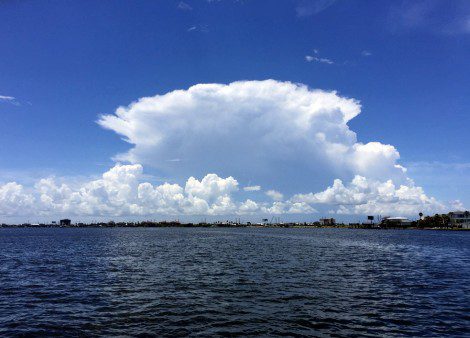
What is Your Boat’s Sail Area?
I have asked that question of many powerboaters, and often the answer is “None. I don’t have any sails.” That, of course, tells me they don’t understand the concept of sail area. Your sail area is the amount of surface of your boat above the waterline (the hull topsides) which is affected by wind. The wind acts upon hull topsides, superstructure, and, on small boats, the crew. Knowledge of how the wind affects your vessel is very important in all close quarter situations such as docking, recovery of an object in the water, and maneuvering close to another vessel. A good knowledge of how the wind affects your boat becomes critical even with light winds when it comes to approaching the loading ramp and your trailer or when coming into the dock.
Wind Shadow
A wind shadow is a calm area caused by something such as a pier or other structure, or even a vessel, blocking a portion of the wind, thus reducing the wind force on your boat. Piers, docks, and jetties are often designed with the purpose of creating a wind shadow. The boat operator should look for any wind shadow the vessel or pier makes by blocking the wind, and plan maneuvers keeping the wind shadow in mind. A pennant or flag flown on your vessel can serve to alert you to any wind shadows. When maneuvering alongside another vessel, it is better to be in a wind shadow of that vessel than to be subject to the full force of the wind. I like to think of the Cat Stevens song “Moonshadow” when I think of the term wind shadow. Just substitute wind for moon:
Yes, I’m being followed by a wind shadow
Wind shadow, wind shadow
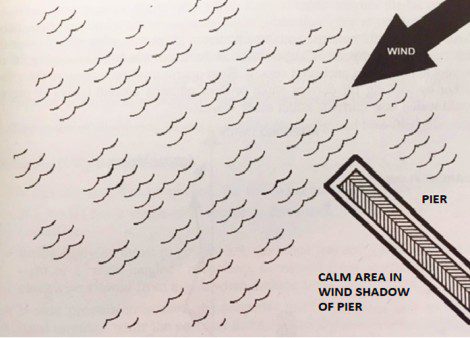
Summary
Knowledge of how your boat responds to different wind strengths and wind directions is critical to returning safely to the dock. Make use of this knowledge when planning your outings on the water, and don’t hesitate to delay or forgo the trip if it is apparent that the wind and weather are not favorable to your boat. Don’t forget to file a float plan with a friend or relative, and tell them to report you to the Coast Guard as a late boater if they don’t hear from you at the planned time.
Maria … Maria …
And they call the wind Maria.
For more information on boating safety, please visit the Official Website of the U.S. Coast Guard’s Boating Safety Division at www.uscgboating.org. SAFE BOATING!
[BC: Nov-15-2022]

 Posted in
Posted in 
























